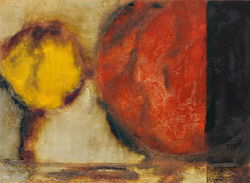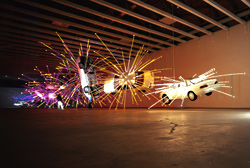Born into a family of seafarers, and having lived in port towns most of her life, Mercer Island painter Melinda Hannigan, 57, has long found inspiration in the rusted hulls of weathered ships streaked by the opalescent residue of oily water. But after a two-month residency in Westport, Ireland, this past spring, the prolific artist has produced a portfolio full of new paintings inspired by the home place of her grandparents. The rocky terrain and the rich colors of the rain-soaked landscape offered her a new emotional and textural palette to draw from, yet this shift in focus is only subtly discernible in the 21 paintings on display in her latest (and first solo) show of “New Works” at Ballard Fetherston Gallery. Her work continues to be richly layered and sophisticated in execution, and viscerally evocative despite a primarily abstract vocabulary. In some of the paintings, numbers and letters still emerge from the tides of blended color, echoing the markings found on what Hannigan calls the “skin” of ships. To make her Ireland paintings more transportable, she chose to use heavy watercolor paper instead of canvas—a decision not merely practical but inspired, for it gives the paintings a supple naturalness quite distinct from what can be achieved with less-yielding canvas. Yet these are not flimsy pictures. As always, Hannigan applies her paint in rich layers, using both a brush and then a palette knife deftly to scrape and sometimes score the surface, a technique that here imitates the angled rain of her temporary residence. Her beautiful palette ranges from tinted turquoise to the deep orange of embers and shadowy charcoal, and she adds texture to her burnished oils by mixing in tiny glass beads, the kind found in road safety paint, giving her canvases a gentle luminescence when tilted toward the light. Some of the particularly handsome pictures from this collection (all “Untitled” and simply numbered) are divided into two or more panels, separated by
masking tape that she pulls away in the end, leaving a primarily clean white line with some underlying colors seeping through. These new paintings are far less a departure from Hannigan’s previous work than they may at first seem. And that is fortunate. SUE PETERS








